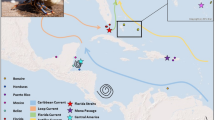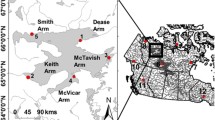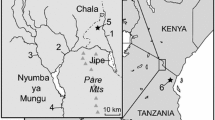Abstract
In most lamprey genera, “paired” species exist in which the larvae are morphologically similar or indistinguishable but, following metamorphosis, one species becomes parasitic while the other bypasses the adult feeding phase and rapidly becomes sexually mature. Since DNA barcoding and similar studies using short segments of the mitochondrial genome do not provide sufficient resolution to distinguish between recent divergence and a lack thereof, the current study examined the relationship between the parasitic silver lamprey (Ichthyomyzon unicuspis) and nonparasitic northern brook lamprey (I. fossor) using up to 10,230 bp from the mitochondrial genome to make phylogenetic inferences and mitochondrial restriction fragment length polymorphism (RFLP) and microsatellite markers to test for significant differences in allele frequencies. We found that silver and northern brook lampreys are not reciprocally monophyletic; two lineages were observed but each occurred within both species. There also were no significant range-wide differences in RFLP haplotype or microsatellite allele frequencies between the species, nor were there significant differences where they occurred sympatrically within the Lake Huron basin. Significant genetic differentiation was found only within the Lake Michigan basin where the results were potentially confounded by geographic separation. Our results thus support suggestions that silver and northern brook lampreys represent ecotypes of a single species since, where they are sympatric, they appear to be experiencing ongoing gene flow. However, alternative life history strategies can be important for a species’ long-term persistence, and critical data are needed to decide whether these two feeding types should be managed as a single unit.


Similar content being viewed by others
References
April J, Mayden RL, Hanner RH, Bernatchez L (2011) Genetic calibration of species diversity among North America’s freshwater fishes. Proc Natl Acad Sci USA 108:10602–10607
Beamish RJ, Neville CM (1992) The importance of size as an isolating mechanism in lampreys. Copeia 1992:191–196
Blank M, Jurss K, Bastrop R (2008) A mitochondrial multigene approach contributing to the systematics of the brook and river lampreys and the phylogenetic position of Eudontomyzon mariae. Can J Fish Aquat Sci 65:2780–2790
Bryan MB, Libants SV, Warrilow JA, Li W, Scribner KT (2003) Polymorphic microsatellite markers for the landlocked sea lamprey, Petromyzon marinus. Conserv Genet 4:113–116
Bryan MB, Zalinksi D, Filcek KB, Libants S, Li W, Scribner KT (2005) Patterns of invasion and colonization of the sea lamprey (Petromyzon marinus) in North America as revealed by microsatellite genotypes. Mol Ecol 14:3757–3773
Cochran PA, Marks JE (1995) Biology of the silver lamprey, Ichthyomyzon unicuspis, in Green Bay and the lower Fox River, with a comparison to the sea lamprey, Petromyzon marinus. Copeia 1995:409–421
COSEWIC (2007) COSEWIC assessment and update status report on the northern brook lamprey Ichthyomyzon fossor (Great Lakes—Upper St. Lawrence populations and Saskatchewan—Nelson population) in Canada. Committee on the Status of Endangered Wildlife in Canada, Ottawa
COSEWIC (2010) Committee on the Status of Endangered Wildlife in Canada Operations and Procedures Manual, January 2010, Ottawa
COSEWIC (2011) COSEWIC assessment and status report on the Silver Lamprey Ichthyomyzon unicuspis, Great Lakes—Upper St. Lawrence populations and Saskatchewan—Nelson Rivers population) in Canada. Committee on the Status of Endangered Wildlife in Canada, Ottawa
Crandall KA, Bininda-Emonds ORP, Mace GM, Wayne RK (2000) Considering evolutionary processes in conservation biology. Trends Ecol Evol 17:390–395
Delarbre C, Escriva H, Gallut C, Barriel V, Kourilsky P, Janvier P, Laudet V, Gachelin G (2000) The complete nucleotide sequence of the mitochondrial DNA of the agnathan Lampetra fluviatilis: bearings on the phylogeny of cyclostomes. Mol Biol Evol 17:519–529
Docker MF (2009) A review of the evolution of nonparasitism in lampreys and an update of the paired species concept. In: Brown LR, Chase SD, Moyle PB, Beamish RJ, Mesa MG (eds) Biology, management, and conservation of lampreys in North America. American Fisheries Society, Symposium 72, Bethesda, pp 71–114
Docker MF, Youson JH, Beamish RJ, Devlin RH (1999) Phylogeny of the lamprey genus Lampetra inferred from mitochondrial cytochrome b and ND3 gene sequences. Can J Fish Aquat Sci 56:2340–2349
Emel SL, Bonett RM (2011) Considering alternative life history modes and genetic divergence in conservation: a case study of the Oklahoma salamander. Conserv Genet 12:1243–1259
Espanhol R, Almeida PR, Alves MJ (2007) Evolutionary history of lamprey paired species Lampetra fluviatilis (L.) and Lampetra planeri (Bloch) as inferred from mitochondrial DNA variation. Mol Ecol 16:1909–1924
Excoffier L, Smouse P, Quattro J (1992) Analysis of molecular variance inferred from metric distances among DNA haplotypes: application to human mitochondrial DNA restriction data. Genetics 131:479–491
Excoffier L, Laval G, Schneider S (2005) Arlequin ver. 3.0: an integrated software package for population genetics data analysis. Evol Bioinform 1:47–50
Felsenstein J (1985) Confidence limits on phylogenies: an approach using the bootstrap. Evolution 39:783–791
Filcek KB, Gilmore SA, Scribner KT, Jones ML (2005) Discriminating lamprey species using multilocus microsatellite genotypes. N Am J Fish Man 25:502–509
Fraser DJ, Bernatchez L (2001) Adaptive evolutionary conservation: towards a unified concept for defining conservation units. Mol Ecol 10:2741–2752
Gill HS, Renaud CB, Chapleau F, Mayden RL, Potter IC (2003) Phylogeny of living parasitic lampreys (Petromyzontiformes) based on morphological data. Copeia 2003:687–703
Haldane JBS (1954) An exact test for randomness of mating. J Genet 52:631–635
Hasegawa M, Kishino H, Yano T (1985) Dating the human-ape splitting by a molecular clock of mitochondrial DNA. J Mol Evol 22:160–174
Hebert PDN, Cywinska A, Ball SL, deWaard JR (2003) Biological identifications through DNA barcodes. Proc R Soc B 270:313–321
Higgins DG, Sharp PM (1989) Fast and sensitive multiple sequence alignments on a microcomputer. Comput Appl Biosci 5:151–153
Hubbs CL, Potter IC (1971) Distribution, phylogeny and taxonomy. In: Hardisty MW, Potter IC (eds) The biology of lampreys, vol 1. Academic Press, New York, pp 1–65
Hubbs CL, Trautman MB (1937) A revision of the lamprey genus Ichthyomyzon. Misc Publ Mus Zool Univ Mich 35:7–109
Hubert N, Hanner R, Holm E, Mandrak NE, Taylor E, Burridge M, Watkinson D, Dumont P, Curry A, Bentzen P, Zhang J, April J, Bernatchez L (2008) Identifying Canadian freshwater fishes through DNA barcodes. PLoS One 3:e2490. doi:10.1371/journal.pone.0002490
International Commission for Zoological Nomenclature (1999) International Code for Zoological Nomenclature, 4th edn. International Trust for Zoological Nomenclature, London
Jenkins RE, Burkhead NM (1994) Freshwater fishes of Virginia. American Fisheries Society, Bethesda
King EL, Gabel JA (1985) Comparative toxicity of the lampricide 3-trifluoromethyl-4-nitrophenol to ammocoetes of three species of lampreys. Lakes Fishery Commission technical report 47, Ann Arbor
Lang NJ, Roe KJ, Renaud CB, Gill HS, Potter IC, Freyhof J, Naseka AM, Cochran P, Perez HE, Habit EM, Kuhajda BR, Neely DA, Reshetnikov YS, Salnikov VB, Stoumboudi MT, Mayden RL (2009) Novel relationships among lampreys (Petromyzontiformes) revealed by a taxonomically comprehensive molecular data set. In: Brown LR, Chase SD, Moyle PB, Beamish RJ, Mesa MG (eds) Biology, management, and conservation of lampreys in North America. American Fisheries Society, Symposium 72, Bethesda, pp 41–55
Larkin MA, Blackshields G, Brown NP, Chenna R, McGettigan PA, McWilliam H, Valentin F, Wallace IM, Wilm A, Lopez R, Thompson JD, Gibson TJ, Higgins DG (2007) Clustal W and Clustal X version 2.0. Bioinformatics 23:2947–2948
Lee W-J, Kocher TD (1995) Complete sequence of a sea lamprey (Petromyzon marinus) mitochondrial genome: early establishment of the vertebrate genome organization. Genetics 139:873–887
Mandrak NE, Crossman EJ (1992) Postglacial dispersal of freshwater fishes into Ontario. Can J Zool 70:2247–2259
Marijnissen SAE, Michel E, Daniels SR, Erpenbeck D, Menken SBJ, Schram FR (2006) Molecular evidence for recent divergence of Lake Tanganyika endemic crabs (Decapoda: Platyhelphusidae). Mol Phylogenet Evol 40:628–634
Mayden RL (1997) A hierarchy of species concepts: the denouement in the saga of the species problem. In: Claridge HA, Dawah HA, Wilson MR (eds) Species: the units of biodiversity. Chapman and Hall, New York, pp 381–424
Moritz C, Cicero C (2004) DNA barcoding: promise and pitfalls. PLoS Biol 2:1529–1531
NatureServe (2010) NatureServe Explorer: an online encyclopedia of life, version 7.1. NatureServe, Arlington. http://www.natureserve.org/explorer. Accessed 17 Oct 2011
Neave FB, Mandrak NE, Docker MF, Noakes DL (2007) An attempt to differentiate sympatric lchthyomyzon ammocoetes using meristic, morphological, pigmentation, and gonad analyses. Can J Zool 85:549–560
Oxford Molecular Ltd (1998) OMIGA v1.1 user’s guide. Oxford Molecular Products, Campbell
Pestano J, Brown RP, Suárez NM, Báez M (2003) Diversification of sympatric Sapromyza (Diptera: Lauxaniidae) from Madeira: six morphological species but only four mtDNA lineages. Mol Phylogenet Evol 27:422–428
Posada D, Crandall KA (1998) Modeltest: testing the model of DNA substitution. Bioinformatics 14:817–818
Raymond M, Rousset F (1995) GENEPOP (version 1.2): population genetics software for exact tests and ecumenicism. J Hered 86:248–249
Ronquist F, Huelsenbeck JP (2003) MRBAYES 3: Bayesian phylogenetic inference under mixed models. Bioinformatics 19:1572–1574
Ronquist F, Huelsenbeck JP (2005) Bayesian analysis of molecular evolution using MrBayes. In: Nielsen R (ed) Statistical methods in molecular evolution. Springer, New York, pp 183–232
Schreiber A, Engelhorn R (1998) Population genetics of a cyclostome species pair, river lamprey (Lampetra fluviatilis L.) and brook lamprey (Lampetra planeri Bloch). J Zool Syst Evol Res 36:85–99
Schuldt RJ, Goold R (1980) Changes in the distribution of native lampreys in Lake Superior tributaries in response to sea lamprey (Petromyzon marinus) control, 1953–77. Can J Fish Aquat Sci 37:1872–1885
Scott WB, Crossman EJ (1973) Freshwater fishes of Canada. Bull Fish Res Board Can 184, Ottawa
Swofford DL (2002) PAUP*. Phylogenetic analysis using parsimony (*and other methods), version 4. Sinauer Associates, Sunderland
Tamura K, Dudley J, Nei M, Kumar S (2007) MEGA4: Molecular Evolutionary Genetics Analysis (MEGA) software version 4.0. Mol Biol Evol 24:596–1599
Taylor EB (1998) Microsatellites isolated from the threespine stickleback Gasterosteus aculeatus. Mol Ecol 7:930–931
Taylor EB (1999) Species pairs of north temperate freshwater fishes: taxonomy, evolution, and conservation. Rev Fish Biol Fish 9:299–324
Vladykov VD, Kott E (1979) Satellite species among the holarctic lampreys (Petromyzonidae). Can J Zool 57:860–867
Waldman JR, Grunwald C, Roy NK, Wirgin II (2004) Mitochondrial DNA analysis indicates sea lampreys are indigenous to Lake Ontario. Trans Am Fish Soc 133:950–960
Waldman J, Grunwald C, Wirgin I (2008) Sea lamprey Petromyzon marinus: an exception to the rule of homing in anadromous fishes. Biol Lett 4:659–662
Waples RS (1991) Pacific salmon, Oncorhynchus spp. and the definition of “species” under the Endangered Species Act. Mar Fish Rev 53:11–22
Ward RD (2009) DNA barcode divergence among species and genera of birds and fishes. Mol Ecol Res 9:1077–1085
Wu GCC, Chiang HC, Chou YW, Wong ZR, Hsu CC, Chen CY, Yang HY (2010) Phylogeography of yellowfin tuna (Thunnus albacares) in the Western Pacific and the Western Indian Oceans inferred from mitochondrial DNA. Fish Res 105:248–253
Yamazaki Y, Yokoyama R, Nishida M, Goto A (2006) Taxonomy and molecular phylogeny of Lethenteron lampreys in eastern Eurasia. J Fish Biol 68:251–269
Yang Z (1994) Maximum likelihood phylogenetic estimation from DNA sequences with variable rates over sites: approximate methods. J Mol Evol 39:306–314
Zanandrea G (1959) Speciation among lampreys. Nature 184:360
Acknowledgments
We thank Fraser Neave (Sea Lamprey Control Centre, Fisheries and Oceans Canada), Wayne Bouffard (U.S. Fish and Wildlife Service), Doug Carlson (N.Y. State Department of Environmental Conservation), Mary Henson and Shawn Nowicki (U.S. Fish and Wildlife Service, Marquette MI), and other DFO and USFWS personnel for sample collections. We are also indebted to Kim Scribner and Kristi Filcek for providing DNA from samples used in their previous microsatellite publication for use as standards, to Rebecca Provost for technical assistance with the mitochondrial RFLP assays, and to David Boguski and Craig McFarlane for help with data analysis and figures. Funding for this project was provided by the Great Lakes Fishery Commission (MFD, NEM, and DDH), Natural Sciences and Engineering Research Council of Canada (MFD, DDH), and the Species at Risk Program of Fisheries and Oceans Canada (NEM).
Author information
Authors and Affiliations
Corresponding author
Electronic supplementary material
Below is the link to the electronic supplementary material.
Rights and permissions
About this article
Cite this article
Docker, M.F., Mandrak, N.E. & Heath, D.D. Contemporary gene flow between “paired” silver (Ichthyomyzon unicuspis) and northern brook (I. fossor) lampreys: implications for conservation. Conserv Genet 13, 823–835 (2012). https://doi.org/10.1007/s10592-012-0332-3
Received:
Accepted:
Published:
Issue Date:
DOI: https://doi.org/10.1007/s10592-012-0332-3




